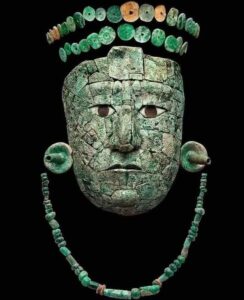Introduction
The Mask of the Red Queen, an exquisite artifact from the Maya civilization, offers profound insights into the culture, beliefs, and artistic achievements of this ancient society. Created in 672 CE, this remarkable piece was discovered in the ancient city of Palenque, Mexico, and it serves as a testament to the sophistication of Maya craftsmanship and their complex cosmology.

Historical Context
Palenque, one of the most important Maya city-states, thrived during the Classic Period (250-900 CE). It was renowned for its impressive architecture, art, and hieroglyphic inscriptions. The Mask of the Red Queen was found within Temple XIII, a burial site reserved for the elite, indicating the high status of the individual interred there. The noblewoman, often referred to as the “Red Queen,” was buried with great honor, reflecting the societal values placed on lineage and the afterlife.
Material Composition and Significance
The mask is a stunning example of Maya artistry, crafted from precious materials, including jadeite, malachite, shell, obsidian, and limestone. The predominant use of jadeite and malachite gives the mask its distinctive greenish hue, symbolizing fertility, life, and renewal. In Maya culture, jade was highly revered, believed to connect the living with the divine and facilitate a smooth transition to the afterlife. The choice of materials not only signifies the wealth and power of the Red Queen but also her connection to the spiritual realm.

Symbolism and Cultural Importance
The Mask of the Red Queen is more than just a burial artifact; it is a rich symbol of Maya beliefs. The vibrant colors and intricate designs are thought to represent various aspects of life and death. The Maya viewed the afterlife as a continuation of existence, where the deceased would live among the gods. The mask’s embellishments may include symbols related to fertility and resurrection, reinforcing the belief in the cyclical nature of life. By adorning the noblewoman with this mask, the Maya ensured her eternal connection to their gods and the cosmic order.

Artistic Techniques
The craftsmanship exhibited in the Mask of the Red Queen highlights the advanced artistic techniques employed by Maya artisans. The combination of materials showcases not only their skill but also their understanding of aesthetics and symbolism. Intricate carvings and inlays suggest a high level of artistry, with each detail carefully designed to convey meaning. The mask’s construction demonstrates the sophisticated trade networks of the Maya, as jade and other materials were often sourced from distant regions.
Conclusion
The Mask of the Red Queen is a remarkable artifact that provides a window into the world of the ancient Maya. Its discovery has greatly contributed to our understanding of Maya society, particularly in terms of their burial practices, beliefs about the afterlife, and the significance of jade as a symbol of divinity. As we continue to study this extraordinary mask, we gain a deeper appreciation for the intricate tapestry of life in the Maya civilization and the enduring legacy they have left behind.
